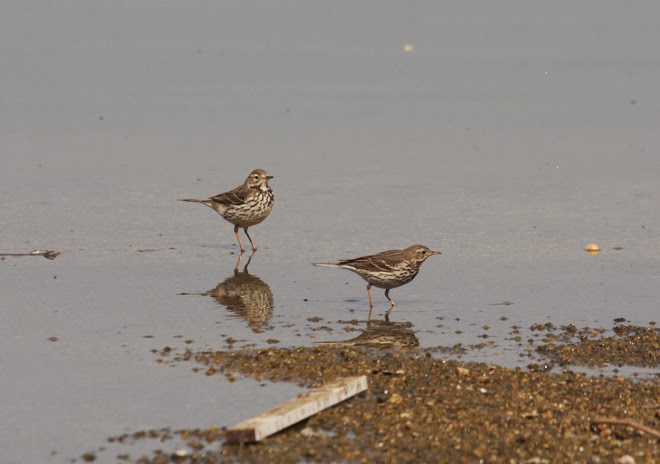Since all the trees along the closer riverside area at between Ogura and Yawata have been felled and the scrub and reeds bulldozed recently a slightly longer journey to Hirakata (towards Osaka) is now necessary to visit more varied habitat. There are some advantages going to Hirakata, the river is much wider with sandy shoals attracting far more ducks and an extensive area of riverside "park" is great for getting views of skylarks.
My plan was to walk up stream and get a return train closer to Kyoto but birding was interesting enough to limit me to just a couple of kilometres in five hours. I started off checking-out the larks which seem far more approachable here compared to on arable land, though in reality I think it's just that they are much easier to spot at distance and thus can be approached more carefully. Many of them were displaying in the calm, mild weather after all the snow last week. As well as the usual display flights, japonicus larks are quite happy to sing from the ground as in the shot below.
A japonicus skylark singing on the ground.
The same bird as above.
The river is wide at this point and scanning through the ducks rimming the sandy islands I saw seven Kentish Plovers (and one Long-billed), these birds always begin to appear in quite large numbers on my gulling river in Osaka in March so it's no surprise to see them turning up here at this time. Though lack of suitable habitat in Kyoto means I rarely see them there despite the close proximity. On the river edge there were a few japonicus Buff-bellied Pipits still very heavily streaked below.
After this I headed upstream where Meadow and Black-faced buntings and Long-tailed Rosefinch were all quite common. I even bumped into the same isabel Meadow Bunting I saw last time I was down this way and the Common Starling was still with the huge flock of White-cheeked Starlings too.
Other interesting sightings included an adult Peregrine upsetting the local Large-billed Crow population and an odd looking Little Egret. It's not unusual to see juvenile Little Egrets with yellowish legs but not so much at the time of year, the tufty hind crown imparted an odd look too.
Little Egret with yellower than usual legs.
The full list of species seen was as follows:-
Gadwall c40
Eurasian Wigeon 150+
Mallard 20+
Northern Pintail 2
Eurasian Teal 50+
Common Pochard 7
Goosander 12+
Great Crested Grebe c15
Grey Heron 6-10
Great White Egret 1
Little Egret 2
Great Cormorant fairly common
Peregrine 1
Osprey 1
Black Kite 2-3
Coot common
Grey-headed Lapwing heard
Long-billed Plover 1
Kentish Plover 7
Common Sandpiper 1
Vega Gull 1
Oriental Turtle Dove common
Common Kingfisher 1
Japanese Pygmy Woodpecker 1
Bull-headed Shrike 3
Carrion Crow common
Large-billed Crow common
Eastern Great Tit several
Long-tailed Tit 2
Skylark 15-20
Brown-eared Bulbul common
Japanese Bush Warbler many singing
White-cheeked Starling common
Common Starling 1
Dusky Thrush common
Pale Thrush 1
Eurasian Tree Sparrow common
White Wagtail common
Japanese Wagtail several
Buff-bellied Pipit 3
Oriental Greenfinch common
Long-tailed Rosefinch fairly common
Meadow Bunting common
Black-faced Bunting common














No comments:
Post a Comment